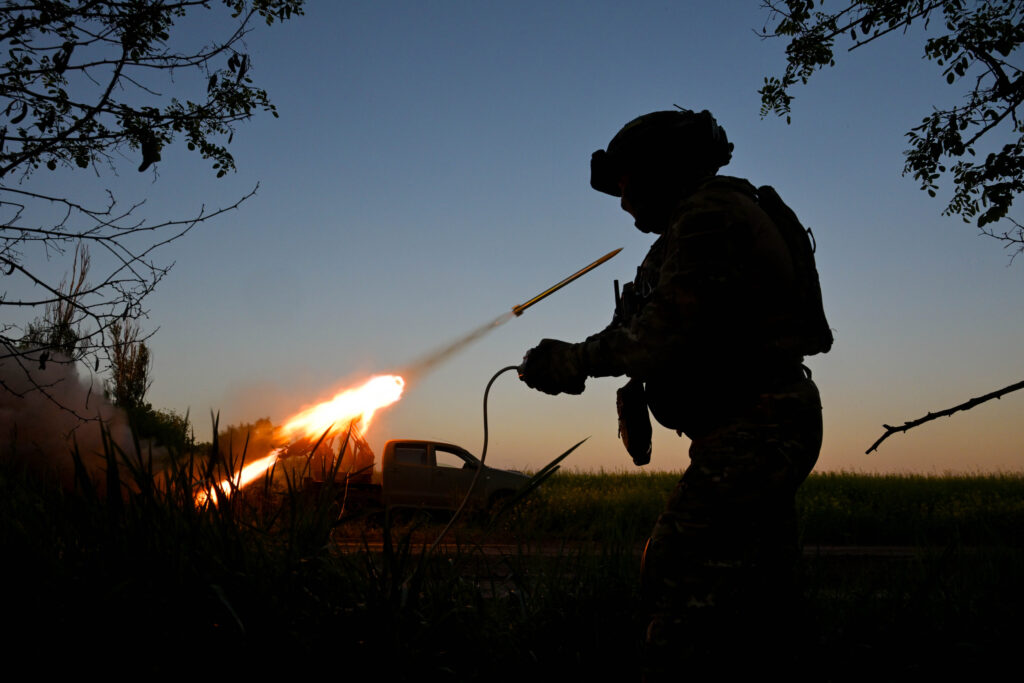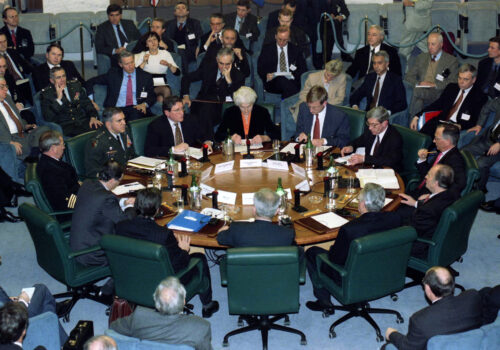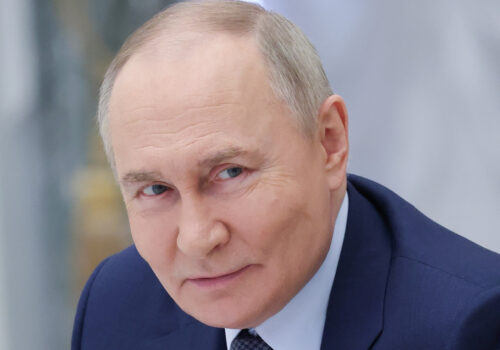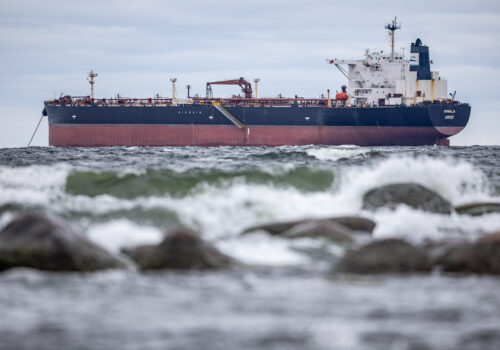This war will be decided on the battlefield.
Four months of chaotic shuttle diplomacy aimed at reaching a cease-fire in Ukraine, multiple phone calls between US President Donald Trump and Kremlin leader Vladimir Putin, repeated US attempts to pressure, browbeat, and bully Ukrainian President Volodymyr Zelenskyy into concessions, have all yielded exactly nothing.
Which is not in the least bit surprising. Because there is no deal to be had with Russia on Ukraine. There never has been, and there never will be.
There is simply no magic formula, no concession, and no grand bargain that would satisfy the Kremlin’s maximalist and eliminationist goals. Moscow wants to end Ukraine’s sovereignty, nationhood, and statehood. Ukraine wants to continue to exist as an independent sovereign state. Given this, no compromise is possible. Any Kabuki negotiations or Potemkin cease-fire would be meaningless and treated by the Kremlin as nothing more than a strategic pause and an opportunity for sanctions relief.
“Russian imperialism will not be neutralized by negotiations, compromises, or concessions,” Andreas Umland, an analyst at the Stockholm Centre for Eastern European Studies and an associate professor at the National University of Kyiv-Mohyla Academy, wrote on May 22.
Following his latest call with Trump, Putin said he wanted any settlement to address what he called the “root causes of the crisis.” That choice of phrase was no accident. The Kremlin leader used a similar formulation when addressing the issue of ending the war during a joint press conference with Belarusian strongman Alyaksandr Lukashenka in March.
Putin’s repeated use of the term “root cause” is a tell. For the Kremlin leader, the root cause of the war is the very existence of Ukraine as a sovereign state, which he has long seen as anathema. At the 2008 NATO Summit in Bucharest, Putin made this clear when he told then US President George W. Bush that “Ukraine is not even a state.” Putin has also repeatedly referred to Ukraine as “little Russia,” a Tsarist-era term to describe Ukrainian lands.
For Putin and the Kremlin elite, Russian colonial dominance of Ukraine is an ideological issue that is not subject to negotiation. The Kremlin cannot be persuaded, it can only be defeated.
Russia’s game: decouple the war from relations with Washington
If anyone doubts Russia’s intentions, then recent remarks by Vladimir Medinsky, one of Putin’s court ideologists and the Kremlin’s chief representative at recent talks in Istanbul, should put them to rest. “Russia,” Medinsky told the Ukrainian delegation, “is prepared to fight forever.” He added, in reference to the Northern War of 1700-1721, which elevated Russia to the status of an empire, “we fought Sweden for twenty-one years. How long are you ready to fight?”
But with the front line largely static and Russia making miniscule gains with high casualties, forever may turn out to be a very long time and have a very steep cost.
According to the Institute for the Study of War (ISW), in the first four months of 2025, Russia advanced just 1,627 square kilometers on the front in eastern Ukraine while suffering 160,600 casualties. That’s a staggeringly high ninety-nine casualties for every square kilometer of territory. ISW also estimates that “at this rate of advance, it would take Russian forces approximately 3.9 years to seize the remainder of Donetsk, Luhansk, Zaporizhzhia, and Kherson oblasts,” the four regions Putin has claimed to have annexed. Moreover, according to ISW, it would take nearly a century to seize all of Ukraine save its Western border regions at a cost of nearly fifty million casualties—which is roughly one third Russia’s current population.
The economics of the war are also not trending in Moscow’s favor. As Charles Lichfield, deputy director of the Atlantic Council’s GeoEconomics Center wrote in February, “while Moscow has found ways to mitigate the impact of [Western sanctions], growing deficits, unsustainable subsidies, and the rising cost of debt servicing” are putting severe strain on the Russian economy.
Additionally, a widely circulated report by Craig Kennedy of Harvard University’s Davis Center for Russian and Eurasian Studies suggests that the “surprising resilience” that the media and analysts have been seeing in the Russian economy is largely a mirage. According to Kennedy’s research, published earlier this year, the war is largely being financed by concessionary off-the-books loans to defense contractors at well below market interest rates. Simply put, this is not sustainable over the long term.
Given this, the Kremlin’s goal vis-à-vis the United States is to decouple the war from Russia-US relations, normalize relations between Moscow and Washington, and get sanctions relief. In a speech in late February, Putin said that Moscow “would be happy to cooperate with any foreign partners, including American companies” to secure rare-earth-minerals deals. Putin added that lifting sanctions could lead to a profitable new economic relationship between the United States and Russia, particularly in the energy sector.
Putin, of course, wants an economic rapprochement without ending his quest to conquer Ukraine. Russia has continued to pound Ukrainian cities with aerial assaults, resulting in mass civilian casualties even as he seeks to entice Washington economically.
And for his part, Trump appears open to the idea. Following his most recent call with Putin, the US president indicated a desire to establish normal economic relations with Moscow. This would be a grave error, as it would throw Putin a lifeline to continue his war of aggression.
Fortunately, there does appear to be pushback in Washington. The Sanctioning Russia Act of 2025, which would expand existing penalties on Russia, was introduced in the US Senate by South Carolina Republican Lindsey Graham and Connecticut Democrat Richard Blumenthal and has more than eighty cosponsors.
Europe’s moment and Ukraine’s resolve
For its part, the European Union (EU) and the United Kingdom have already moved ahead with their own new package of sanctions enacted on May 20, a day after the latest Trump-Putin call. Brussels and London are also pledging to increase military assistance to Ukraine to make up for any shortfall resulting from a US cutoff.
German Chancellor Friedrich Merz, French President Emmanuel Macron, British Prime Minister Keir Starmer, and the EU’s top diplomat, Kaja Kallas, all seem to understand that this could be Europe’s moment. But one of the biggest wildcards going forward is whether Europe can overcome its internal divisions—mainly opposition from Hungary and Slovakia—and surge arms to Ukraine.
Which brings us to Ukraine itself—and here the calculations are simple. As the Ukrainian political scientist Anton Shekhovtsov wrote earlier this week, “Ukraine’s choices are to fight back and risk being killed, or to surrender and be killed. By fighting back, Ukraine has a chance; by surrendering, it has none—making surrender not a viable option.”
And for Ukraine, as always, necessity has become the mother of invention. Faced with a potential shortfall in weapons, Kyiv has created a vibrant domestic arms industry focusing on drone warfare.
“In just three years, Ukraine’s military has evolved from defending itself with leftover Soviet weapons to pioneering a new kind of warfare,” the Ukrainian war correspondent Nataliya Gumenyuk writes in the Atlantic.
“Fortunately for Ukraine, American weapons are not the only factor that has rebalanced the battlefield in the past three years. Starting in 2024, Ukrainian-made drones definitively changed the way both sides waged war. For Ukraine, the adjustment was not just tactical, but a broader, doctrinal evolution in how its military fights.”
Gumenyuk concludes by noting that “as Ukraine’s partners speak of peace deals and security guarantees, Ukraine’s armed forces are adapting in every way they can to continue carrying out their mission . . . They cannot afford the luxury of counting on American commitments or Russian concessions, because for most Ukrainians, what matters above all is physical safety. And the only force protecting human lives in Ukraine is the Ukrainian military.”
So here we are, after three years of war and four months of failed diplomacy to end it. This war will be decided on the battlefield. It is for the United States and Europe to decide whether they are prepared to help Ukraine win it.
Brian Whitmore is a nonresident senior fellow at the Atlantic Council Eurasia Center, an assistant professor of practice at the University of Texas-Arlington, and host of The Power Vertical Podcast.
Further reading
Wed, May 28, 2025
Dispatch from Dayton: What Trump can learn about ending war
Inflection Points By Frederick Kempe
A recent visit of the NATO Parliamentary Assembly to Ohio—thirty years after the Dayton Accords ended the Bosnian War—raised important questions about what lessons can be applied to ending Russia’s war on Ukraine.
Tue, May 27, 2025
Do Trump’s criticisms of Putin mark a turning point in his Russia policy?
New Atlanticist By John E. Herbst
On Sunday, the US president called his Russian counterpart “crazy” on social media, revealing an increasing impatience with Russia over its unwillingness to engage in US-led cease-fire talks.
Wed, May 21, 2025
Europe is striking back at Russia’s shadow fleet. Here’s what to know about the latest EU and UK sanctions.
New Atlanticist By
This week, Brussels and London unveiled new sanctions against Russia and the fleet of oil tankers and other vessels covertly trading in Russian oil. Atlantic Council experts assess the moves.
Image: A soldier of the artillery crew of the Rifle Battalion special unit of the Main Directorate of the National Police of Ukraine in Zaporizhzhia region performs a combat mission using a portable rocket launcher Partizan in the Zaporizhzhia direction, Ukraine, on May 23, 2025 (Photo by Dmytro Smolienko/Ukrinform) (Photo by Ukrinform/Ukrinform/Sipa USA) REUTERS




